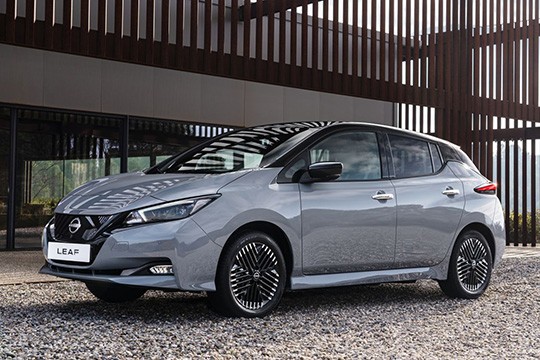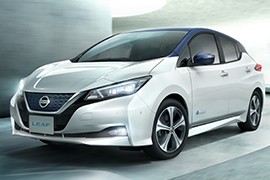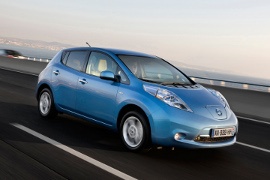NISSAN Leaf Models/Series Timeline, Specifications & Photos
First production year: 2010
Engines: Electric
Body style: Hatchback
Nissan upgraded the second generation of the Leaf, the first mass-market electric vehicle in the world, and increased both the look and the onboard safety systems of the compact-sized EV.
When the first generation of the Leaf was introduced on the market in 2010, it was the ugly duck of the family, but the one that won the 2011 World Car of The Year award. While it wasn't exactly the best bet in the compact segment, it was actually the best offer for an electric vehicle. It proved that the electric mobility was feasible, despite having a network of chargers at its disposal.
But the ugly duck has been transformed into a beautiful swan, which took off in sales and respect on the market. With the refreshed version, the Leaf became more appealing. Its front fascia lost the chromed V-shape from the 2017 model, and that was the most obvious change. The carmaker also offered a new range of 16" and 17" light-alloy wheel options.
Inside, the carmaker upgraded the infotainment unit with the NissanConnect system, which provided Apple CarPlay and Android Auto connectivity. Thus, the driver could get more out of the car, knowing exactly where they could find the next plug to charge the vehicle and even make a reservation for a charging port. In terms of safety, Nissan introduced the ProPilot assistance feature that kept a safe distance from the car in front. It could accelerate, decelerate, or stop accordingly.
In terms of efficiency, the 2022 Leaf boasted a 385 km (239 miles) WLTP range.
Nissan introduced the second generation of the Leaf in late 2017 as a 2018 model year, and it was a much better vehicle than its predecessor, but sharing the same hatchback architecture as before.
The Japanese automaker gambled a lot in 2010 when it launched the Leaf as a full-electric vehicle during the world financial crisis when customers tried to keep their cars and not buy new ones, let alone EVs. Nissan’s gamble was rewarded since it created brand awareness for the Japanese automaker in this new segment of electric vehicles. Still, customers who were used to filling their cars at a gas station in five minutes needed something better.
Furthermore, the Leaf’s price was quite high for a compact-sized hatchback. So, when the automaker introduced the second generation of this nameplate, it improved it in all areas and created a much better vehicle.
With the second generation of the Leaf, the car showed a more mature look with a design that sported a front fascia featuring the V-shaped grille seen on other Nissan models. Its LED headlights flanked it, and the apron that sported the fog lamps looked more conventional and appealing.
From its profile, the hatchback styling with the floating roof design resembled the one from the Micra. To emphasize the ecological vehicle, Nissan placed “Zero Emission” badges on the front doors. On the rear quarter panels, the automaker installed the LED taillights that flanked the tailgate and were extended upwards on the C-pillars.
The first generation of the Leaf was criticized for not providing enough interior space for four adults. Nissan fixed that and increased the car’s wheelbase, making the cabin taller. As a result, the front passengers sat on high-mounted seats with mild bolstered areas. The driver fronted a fully digital instrument cluster and a flat-bottom steering wheel.
On the center stack, Nissan installed the touchscreen for the infotainment system that supported Apple CarPlay and Android Auto, while the center console placed between the front occupants housed the controls for driving modes and a pair of cup holders. The rear seats were mounted even higher than those from upfront since the batteries were mounted underneath them.
There was enough room for two adults in the back, but due to the tall center tunnel that crossed the cabin from front to back, a third middle-seated passenger had trouble finding a good position due to the lack of legroom. Behind the split-folding bench, the automaker created the luggage area, which was good enough for school runs and weekly shopping.
The second generation of the Leaf promised 235 miles (378 km) of range due to its new and improved 40kWh battery pack. Among other essential upgrades, the second generation of the Leaf came with a one-pedal driving system and the ProPilot system that could autonomously keep the car centered on a lane and follow the vehicle in front of it until it completely stopped.
The first generation of the Leaf was a big punch against the internal combustion car market. Even though it wasn't the first electric car, it was the first that mattered.
After a few delays in production, the first Nissan Leaf was launched in 2010. To make the car appealing, it was marketed as a compact hatchback vehicle. It was launched at the same time in Japan and in the U.S. It was the first affordable electric vehicle that could run 160 km (100 miles) on one charge and it could have been recharged from a regular power outlet at home. The charging stations were a dream in 2010.
The car featured a futuristic look, with a sloped front and a high greenhouse. The headlights were installed closer to the A-pillars to protect them from small city crashes. In the front, where the normal cars had the radiators, the Leaf had the charging point behind the Nissan badge. The side view of the windows looked like a leaf.
Inside, the revolutionary design was noticed at the instrument cluster, where the dials were replaced by a TFT display. The speedometer was on a separate display placed on top of the dashboard. On the center stack, a big touch-screen was introduced to control various features of the car. The “gear-stick” was a rotary knob between the seats. In the back, there was enough room for three adults. Since the battery pack was placed underneath the floor, the seating position was higher than in a normal hatchback.
The 2010 Leaf was powered by an 80 kW motor. The standard battery pack could get 24 kWh energy. In late 2016, it was upgraded to a 30 kWh battery pack.


